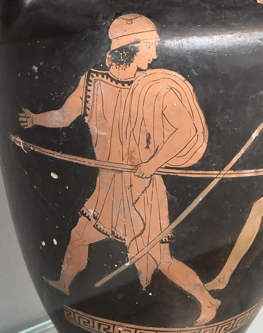Making basic Ancient Greek clothing is pretty easy, even if you don’t sew. The first part of your Ancient Greek kit will be a simple tunic, known as a chiton, and a short cloak called a chlamys.
Greek clothing was mainly finely woven wool or linen. Linen is a common option, as it is hard to find wool that resembles what the ancients would have used. Use only 100% linen and wool (so no blends, cotton or synthetics). Members can advise you on the best places to source appropriate fabrics at a reasonable price.
Chiton
The Chiton is a short tunic (for men) or longer robe (for women or men when more formally dressed).
For men, a chiton is simply two large rectangles of wool or linen sewn together (or easier still, one larger rectangle folded over). As a rough guide, the unbelted chiton should reach from elbow to elbow (with your arms outstretched), and from chin to knee. Usually, both sides are completely sewn up, with the armholes in the top edge, not at the sides. The top is typically pinned (or sometimes sewn) together at two points on either side of the neck hole.
Another style has each side sewn up, with the arm-holes on the sides. This gives the impression of having short sleeves.
Most chitons are represented in artwork as plain or with simple or decorated lines along the bottom. Off-white or natural colours would have been common for everyday clothing, with brighter colours indicating wealth. No surviving clothing has survived from the period, but many pieces of linen (including coloured and embroidered pieces) have been found. Unfortunately, most modern “Greek Key” trims are synthetic or cotton, and so not suitable.
Chitons are often represented in artwork with narrow vertical strips or lines indicating folds or pleats.



Longer, floor-length chitons commonly appear in the artwork on older men and men of higher status, especially in the archaic period. By the 5th Century BCE, longer chitons would be worn by men typically only for ceremonial purposes or special occasions (the “Sunday best”), or as a sign of wealth or priesthood.

Chlamys
The next essential piece of kit is the Chlamys. This is a short cloak, basically a rectangle of wool. Chlamys were worn for travelling, and can come in handy as padding when you carry a shield. A good size is about a meter tall and a little over 2 meters wide. You fold the cloak in half and pin it along the top edge, about 40 centimetres from the fold to make a neck hole. The pin goes over the right shoulder so that your right arm can move freely.

The chlamys can be made of loosely woven wool or linen.

The chlamys, and unsewn chitons, are attached with simple pins, a bit like large safety pins.
Artwork also shows round, disk-shape broaches.

Headwear
Headwear in our period was mostly functional. Headbands were worn with longer or curly hair.
The Pilos was a common felt cap, which can also act as helmet padding. It was round or conical, and worn broadly across the Greek regions in the 5th century.
The Pilos can also act as helmet padding.
The plis, an Albanian felt cap, originated from a similar felt cap worn by the Illyrians, and is worn to this day in Albania and Kosovo.


The petasos is a broad, flat, floppy sunhat, made of felt, straw or leather.
It was worn primarily by farmers and travellers, and was considered characteristic of rural people
Later on, it was commonly seen on cavalry.
Footware
Sandals were the most common form of footwear. Boots were used in colder regions or by cavalry.
It is possible to make your own sandals. Alternatively, you can buy a pair (the group can recommend some sites). Commercially-purchased sandals come in, veg-tanned leather which is a bit too light for historical tanning techniques, so for extra authenticity you can easily dye them.


You can find more detailed guidelines on how to make some these garments elsewhere in this section.


